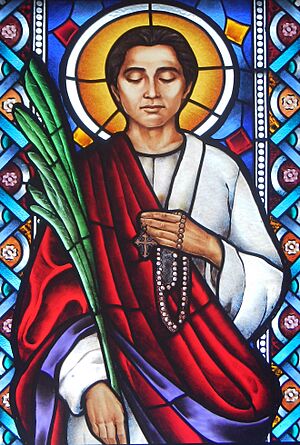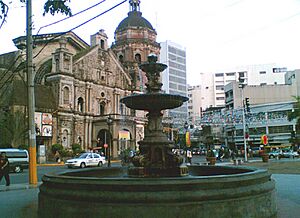Lorenzo Ruiz facts for kids
Quick facts for kids SaintLorenzo Ruiz of Manila TOSD |
|
|---|---|

Ruiz on a stained-glass window in Cubao Cathedral
|
|
| Born | November 28, 1594 Binondo, Manila Captaincy General of the Philippines, Spanish Empire |
| Died | September 29, 1637 (aged 42) Nagasaki, Hizen Province, Tokugawa Shogunate |
| Venerated in | Catholic Church |
| Beatified | February 18, 1981, Manila, Philippines by Pope John Paul II |
| Canonized | October 18, 1987, Vatican City by Pope John Paul II |
| Major shrine | Binondo Church, Binondo, Manila, Philippines |
| Feast | September 28 |
| Attributes | Rosary in clasped hands, gallows and pit, Barong Tagalog or camisa de chino and black trousers, cross, palm of martyrdom |
| Patronage | The Philippines, Filipinos, Overseas Filipino Workers and migrant workers, immigrants, the poor, separated families, Filipino youth, Chinese-Filipinos, Filipino Altar servers, Tagalogs, Archdiocese of Manila. |
| Lorenzo Ruiz | |||||||||||||||
|---|---|---|---|---|---|---|---|---|---|---|---|---|---|---|---|
| Traditional Chinese | 李樂倫 | ||||||||||||||
| Simplified Chinese | 李乐伦 | ||||||||||||||
|
|||||||||||||||
Lorenzo Ruiz (Filipino: Lorenzo Ruiz ng Maynila; Chinese: 李樂倫; Spanish: Lorenzo Ruiz de Manila) was born on November 28, 1594, and died on September 29, 1637. He is also known as Saint Lorenzo of Manila. He is a Filipino saint honored in the Catholic Church.
Lorenzo Ruiz was a Chinese Filipino. He became the first Filipino to be declared a saint. He was executed in Japan by the Tokugawa Shogunate. This happened during a time when Christians in Japan were being persecuted in the 17th century. Saint Lorenzo Ruiz is the patron saint of the Philippines and all Filipino people.
Contents
Early Life of Lorenzo Ruiz
Lorenzo Ruiz was born in Binondo, Manila, on November 28, 1594. His father was Chinese, and his mother was Filipino. Both of his parents were Catholic. His father taught him Chinese, and his mother taught him Tagalog.
Lorenzo worked as an altar boy at the Binondo Church. He was educated by Dominican friars. He became a skilled writer, known as an escribano (a clerk or scribe). He also joined the Cofradía del Santísimo Rosario, which means the Confraternity of the Most Holy Rosary.
Lorenzo married a woman named Rosario, and they had two sons and one daughter. Their family lived a peaceful and religious life.
In 1636, Lorenzo was wrongly accused of killing a Spaniard. To find safety, he boarded a ship. On the ship were three Dominican priests: Antonio Gonzalez, Guillermo Courtet, and Miguel de Aozaraza. There was also a Japanese priest, Vicente Shiwozuka de la Cruz, and a lay man with leprosy, Lázaro of Kyoto. With help from the Dominican fathers, Lorenzo and his companions sailed to Okinawa on June 10, 1636.
Martyrdom and Sacrifice
When Lorenzo arrived in Japan, the Tokugawa Shogunate was persecuting Christians. They feared that Spain might try to invade Japan, similar to how they had taken over the Philippines. The missionaries were arrested and put in prison.
After two years, they were moved to Nagasaki for trial. There, they faced severe torture. On September 27, 1637, Lorenzo and his friends were taken to Nishizaka Hill. They were tortured by being hung upside-down over a pit.
Lorenzo died two days later, on September 29, 1637, when he was 42 years old. This torture method was called tsurushi in Japanese. In Spanish, it was known as horca y hoya, meaning "gallows and pit." This method was very painful. One hand was left free so the person could signal if they wanted to give up their faith. If they did, they would be released.
Despite his great suffering, Lorenzo refused to give up Christianity. He died from blood loss and suffocation. His last words were: "I am a Catholic and wholeheartedly do accept death for God; had I a thousand lives, all these to Him shall I offer."
After his death, Lorenzo's body was cremated. His ashes were then thrown into the sea near Nagasaki. This was done to prevent other Christians from collecting his sacred remains.
Honoring Saint Lorenzo Ruiz
Becoming a Saint: Beatification
The process to declare Lorenzo Ruiz a saint began with a document called a positio. This document was written by a Spanish historian named Fidel Villarroel. A key piece of evidence for Ruiz's martyrdom was an eyewitness account. This account was found by Villaroel in an archive in Rome.
Lorenzo was declared "blessed" (a step before sainthood) during Pope John Paul II's visit to the Philippines in 1981. This was the first time a beatification ceremony was held outside the Vatican.
Becoming a Saint: Canonisation
Lorenzo was declared a "saint" (canonized) by Pope John Paul II on October 18, 1987. He was canonized along with 15 other martyrs from Japan. This made him the first Filipino saint.
A miracle supported Ruiz's canonization. In October 1983, a two-year-old girl named Cecilia Alegria Policarpio was cured of a brain condition called hydrocephalus. Her family and supporters had prayed to Lorenzo for his help. She had been diagnosed with the condition shortly after birth.
A mosaic of San Lorenzo can be found in the Trinity Dome of Mary's National Shrine in Washington D.C. On September 28, 2017, the 30th anniversary of Lorenzo's canonization was celebrated in the Archdiocese of Manila.
Other Ways He is Remembered
Lorenzo Ruiz is featured in the Communion of Saints Tapestries by American painter John Nava. These tapestries show 135 saints and blessed figures. They hang inside the Cathedral of Our Lady of the Angels in Los Angeles, California.
See also
 In Spanish: Lorenzo Ruiz para niños
In Spanish: Lorenzo Ruiz para niños
- Ignacia del Espiritu Santo
- Jerónima de la Asunción
- Kakure Kirishitan
- Martha de San Bernardo, the first Filipino nun
- Martyrs of Japan
- Pedro Calungsod, the second Filipino saint



